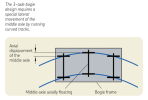This might be a slightly basic question for those of you who actually work on rolling stock but I've not been able to figure it out from Googling.
Looking at the Class 99, I see it will be built in Co-Co formation with bogies that have 6 wheels.
Now, I'm familiar with how train wheels are conic sections which enables them to roll at slightly different speeds while leaning around a bend. But with a six wheeled bogie, wouldn't a fixed middle axle be out of alignment with the rails on the way around a bend?
Is the simple answer that the middle axle is somewhat free to move laterally? Is this also the case on steam locomotives that often seem to have various sizes of wheels all the way down?
Answers much appreciated!
Looking at the Class 99, I see it will be built in Co-Co formation with bogies that have 6 wheels.
Now, I'm familiar with how train wheels are conic sections which enables them to roll at slightly different speeds while leaning around a bend. But with a six wheeled bogie, wouldn't a fixed middle axle be out of alignment with the rails on the way around a bend?
Is the simple answer that the middle axle is somewhat free to move laterally? Is this also the case on steam locomotives that often seem to have various sizes of wheels all the way down?
Answers much appreciated!


